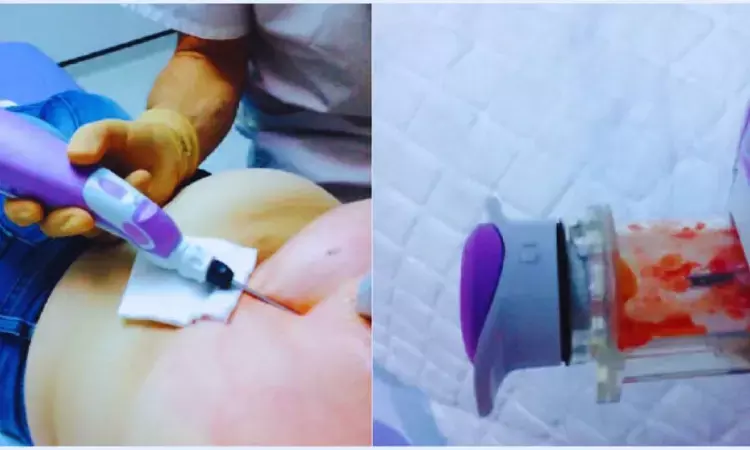- Home
- Medical news & Guidelines
- Anesthesiology
- Cardiology and CTVS
- Critical Care
- Dentistry
- Dermatology
- Diabetes and Endocrinology
- ENT
- Gastroenterology
- Medicine
- Nephrology
- Neurology
- Obstretics-Gynaecology
- Oncology
- Ophthalmology
- Orthopaedics
- Pediatrics-Neonatology
- Psychiatry
- Pulmonology
- Radiology
- Surgery
- Urology
- Laboratory Medicine
- Diet
- Nursing
- Paramedical
- Physiotherapy
- Health news
- Fact Check
- Bone Health Fact Check
- Brain Health Fact Check
- Cancer Related Fact Check
- Child Care Fact Check
- Dental and oral health fact check
- Diabetes and metabolic health fact check
- Diet and Nutrition Fact Check
- Eye and ENT Care Fact Check
- Fitness fact check
- Gut health fact check
- Heart health fact check
- Kidney health fact check
- Medical education fact check
- Men's health fact check
- Respiratory fact check
- Skin and hair care fact check
- Vaccine and Immunization fact check
- Women's health fact check
- AYUSH
- State News
- Andaman and Nicobar Islands
- Andhra Pradesh
- Arunachal Pradesh
- Assam
- Bihar
- Chandigarh
- Chattisgarh
- Dadra and Nagar Haveli
- Daman and Diu
- Delhi
- Goa
- Gujarat
- Haryana
- Himachal Pradesh
- Jammu & Kashmir
- Jharkhand
- Karnataka
- Kerala
- Ladakh
- Lakshadweep
- Madhya Pradesh
- Maharashtra
- Manipur
- Meghalaya
- Mizoram
- Nagaland
- Odisha
- Puducherry
- Punjab
- Rajasthan
- Sikkim
- Tamil Nadu
- Telangana
- Tripura
- Uttar Pradesh
- Uttrakhand
- West Bengal
- Medical Education
- Industry
Is ultrasound-guided vacuum-assisted excision reliable for removing small breast cancers?

Finland: A recent study published in the European Journal of Radiology has suggested that ultrasound-guided vacuum-assisted excision (VAE) is not a reliable method for removing small breast cancers.
Michaela Björnström, University of Helsinki and Helsinki University Hospital, Finland, and colleagues revealed that none of the small invasive breast cancer was completely removed with VAE under ultrasound guidance, therefore, they suggested that it is not a reliable method for the removal of small breast cancers. However, they also revealed that after the excision of visible lesions, there are still small foci of cancer and ductal carcinoma in situ (DCIS) left, implying that a larger amount of tissue than visible on ultrasound needs to be removed for complete lesion excision.
Cancer detection comes earlier when tumours are smaller with advancements in imaging technology such as screening mammography. Currently, it is challenging to determine which of these small tumours will become malignant, VAE under local anaesthesia is a method that safely removes tumours.
Previous studies have suggested that this method is successful in the removal of nonmalignant lesions. However, the research team point out a lack of data on whether VAE is reliable for removing small breast cancers. Therefore, Björnström and colleagues aimed to evaluate if it is possible to completely remove small breast cancer tumours with vacuum-assisted excision (VAE) under ultrasound guidance.
For this purpose, the researchers selected women ≥ 50 years old with a biopsy-proven invasive cancer ≤ 10 mm based on referrals and enrolled in the prospective study. To remove the tumour, the patients underwent VAE within six weeks after the biopsy. Following the excision of the tumour and shaving of biopsy cavities margins, a radioactive seed was inserted into the biopsy cavity.
Surgical excision was done of the VAE excision cavity and surrounding tissue. Preliminary VAE results were assessed after ten patients. For the study to progress at least 80 % of the breast cancer tumours had to be completely removed by VAE.
The study led to the following findings:
- The tumour median size in mammography was 8.5 mm and in ultrasound 6.5 mm.
- The shape of the lesion was round in three (30 %), oval in two (20 %) and irregular in five (50 %) patients.
- None of the tumours were completely removed in the first VAE specimen, meaning that there was invasive cancer or ductal carcinoma in situ (DCIS) in the “shaved margins” and/or the surgical specimen.
- In 50 % of the cases, the surgical specimen was free of invasive cancer and DCIS.
The study authors wrote, "Their study size was small, they could not proceed with the study since none of the 10 first tumours treated with VAE could be successfully removed."
They added, "Most of the lesions in the study were located in the breast's fatty part. Breast tumours are heavier than surrounding fat tissue, making it harder for the vacuum to suck out the tumour."
"Slowly growing tumours can consist of tight fibrotic tissue and therefore may be more difficult to remove by vacuum-assisted excision," they concluded.
Reference:
Björnström, M., Niinikoski, L., Arlan, K., Meretoja, T. J., Ståhls, A., & Hukkinen, K. (2023). Vacuum-assisted excision of small breast cancers under ultrasound guidance. European Journal of Radiology, 167, 111049. https://doi.org/10.1016/j.ejrad.2023.111049
Dr Kamal Kant Kohli-MBBS, DTCD- a chest specialist with more than 30 years of practice and a flair for writing clinical articles, Dr Kamal Kant Kohli joined Medical Dialogues as a Chief Editor of Medical News. Besides writing articles, as an editor, he proofreads and verifies all the medical content published on Medical Dialogues including those coming from journals, studies,medical conferences,guidelines etc. Email: drkohli@medicaldialogues.in. Contact no. 011-43720751


